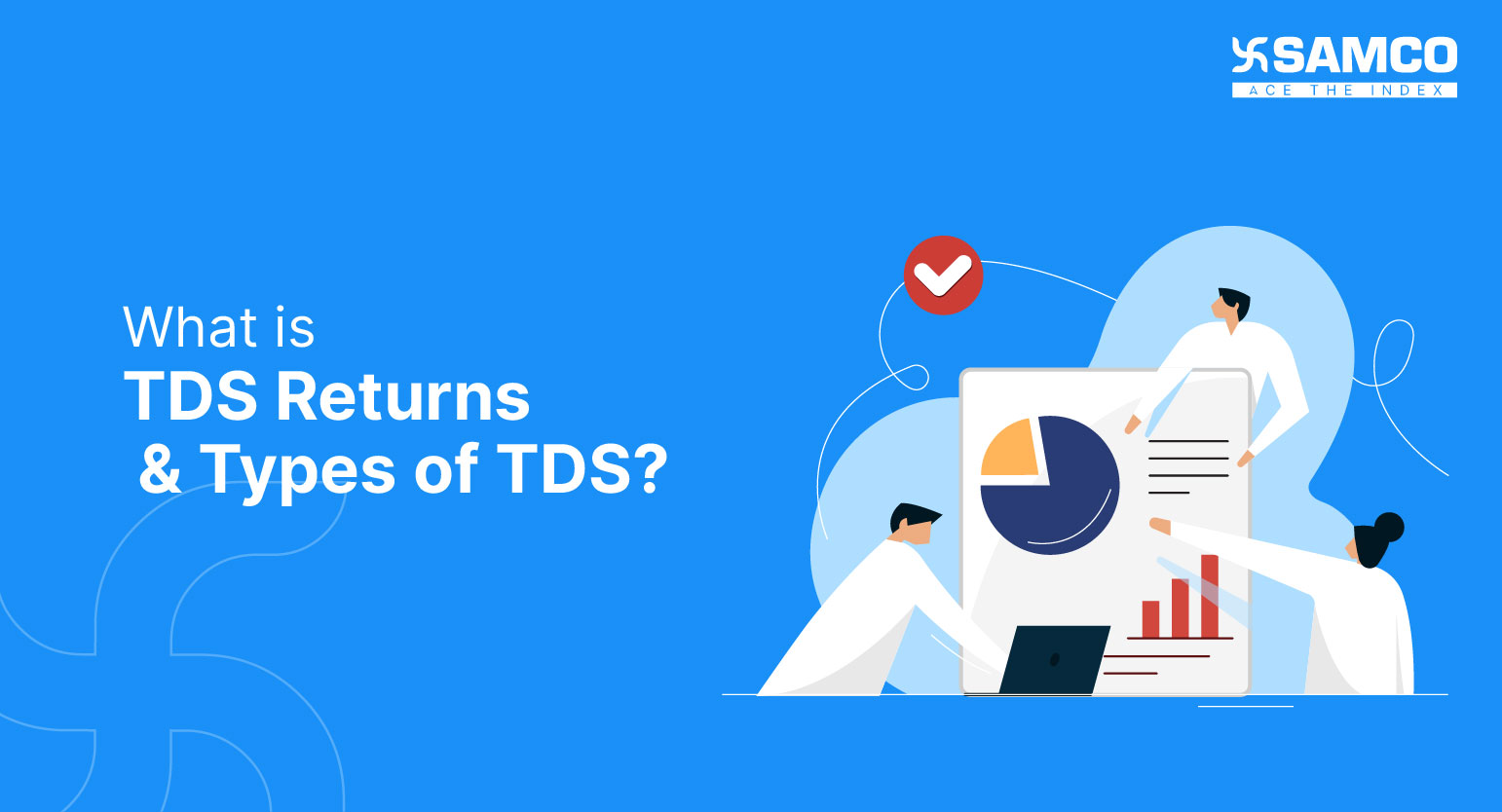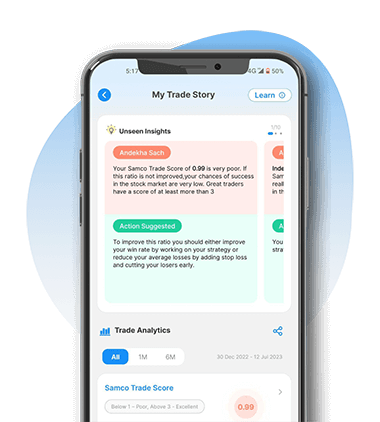In this article, we will cover
- What is TDS Return?
- Incomes Covered Under TDS
- Different Types of TDS Returns Forms
- What are the Requirements for Filing a TDS Return?
- How to File TDS Return?
- Benefits of Filing a TDS Return
- Overview of TDS Rates
- What is the TDS Rate on Salary?
- Samco APP: Your Trading Buddy
- Things to Consider When Filing TDS Returns Online
- How to Choose the Right Professional for TDS Return Filing?

What is TDS Return?
TDS Return is a tax form required to be filed by employers and other entities responsible for deducting tax at source (TDS) from payments they make. The form requires the employer to declare the income earned and the tax deducted on such income. It must be filed within the prescribed time period to avoid any penalty or interest.Incomes Covered Under TDS
- Salary
- Bank interest
- Amount under LIC
- Brokerage or commission
- Compensation on acquiring immovable property
- Contractor payments
- Commission payments
- Deemed dividend
- Interest apart from interest on securities
- Insurance commission
- Winning from games like a crossword puzzle, card, lottery, etc.
- Interest on securities
- Remuneration paid to the Director of a company
- Payment of rent
- Transfer of immovable property
Different Types of TDS Returns Forms
| Type of TDS Return Forms | Description |
| Form 24Q |
|
| Form 26Q |
|
| Form 27Q |
|
| Form 27EQ |
|
What are the Requirements for Filing a TDS Return?
The requirements for filing a TDS Return are as follows:- Having the details before TDS return filing
- Verifying the details before submission
- Paying upload fees (plus applicable GST) for filing the return at a TIN-FC
- Submitting documents such as TDS certificate tax payment challans, TAN details, PAN card details, notice details, and all bank account information.
- Main categories of TDS filing categories include salary, interest, property, capital gains, and miscellaneous income.
- Furnishing a tax residency certificate obtained from the tax authorities of its resident country along with a self-declaration of not carrying on any business in India through a permanent establishment.
- Obtaining a TAN, collating payee details, determining the applicable TDS rate, and filing the return with the Income Tax Department.
How to File TDS Return?
Offline Mode for TDS Return File
Filing a TDS return offline involves the following steps:- Download the TDS return form from the Income Tax Department website https://www.tin-nsdl.com/services/etds-etcs/etds-rpu.html.
- Fill in all the details in the form.
- Take a printout of the form and sign it.
- Attach the relevant documents and proof of payments made to the form.
- Send the form to the designated Income Tax Department office via post or courier.
- Wait for the Income Tax Department to process the form and issue a confirmation.
Online Mode for TDS Return File
Filing a TDS return can be done in a few simple steps and should be done by the taxpayer regularly. Here is a step-by-step guide to filing a TDS return online:- Log in to the Income Tax e-Filing Portal.
- Select the 'TDS' tab on the left side menu.
- Select the 'TDS Returns' option from the drop-down menu.
- Select the type of TDS return you need to file.
- Enter all the necessary details related to the TDS return.
- Upload the necessary documents and certify the TDS return.
- Submit the TDS return and wait for confirmation of the submission.
- After submitting the TDS return, a confirmation page will appear with the acknowledgment number.
- Download and save the confirmation page for future reference.
Benefits of Filing a TDS Return
Filing timely TDS returns offers several benefits, including- Taxpayers filing TDS returns can avoid penalties and late fees.
- It helps you to track your income and tax paid in an organized way.
- It allows the taxpayer to access their TDS refund without issues.
- It helps keep accurate records of your income, deductions, and other tax-related and financial information.
- It helps to maintain compliance with the Income Tax Act 1961 and other related acts.
- Filing TDS returns can reduce the financial burden of paying taxes on time by allowing the taxpayer to plan out the payments.
- TDS return filing can help obtain loans and financial aid from banks and other financial institutions.
- It can help prepare and file income tax returns accurately and hassle-free.
Overview of TDS Rates
| Income Type | TDS Rate |
| Salary | Applicable Slab Rate |
| Fixed deposit interest | 10% |
| Bonds | 10% |
| Insurance commissions | 5% |
| Contractor services | 1% or 2% |
| Rent | 2% or 10% or 5% |
| Shares/mutual funds | Nil |
| Savings account interest | Nil |
| NCDs listed on exchange | Nil |
| Property | 1% |
| Brokerage | 5% |
| Professional and technical services | 10% |
What is the TDS Rate on Salary?
The TDS rate on salary is determined by the income you get from your employer, which determines your tax slab rate. The percentage of TDS deduction on pay will vary from 10% to 30%, depending on the tax slab.Under the old tax system, if you were under 60:
- TDS is 0% for income under 2.5 lakhs.
- TDS is 5% if your income is 2.5–5 lakhs.
- 20% TDS applies to income between 5 and 10 lakhs.
- 30% TDS applies to income above 10 lakhs.
Under the new tax system, if you're under 60:
- TDS is 0% for income under 2.5 lakhs.
- TDS is 5% if your income is 2.5–5 lakhs.
- TDS is 10% for income between 5 lakhs and 7.5 lakhs.
- 15% TDS applies to income between 7.5 lakhs and 10 lakhs.
- TDS is 20% if your income exceeds 10 lakhs and 12.5 lakhs.
- TDS is 25% if your income exceeds 12.5 lakhs and less than 15 lakhs.
- TDS is 30% for income beyond 15 lakhs.
TDS Return Deadline
Income taxes are deposited monthly. The TDS return is submitted quarterly. The TDS return for April, May, and June taxes must be submitted in July. TDS return deadlines are extended in March. May is the deadline for the fourth quarter TDS return.| Quarter | Period | Last Date of Filing |
| 1st Quarter | 1st April to 30th June | 31st July 2022 |
| 2nd Quarter | 1st July to 30th September | 31st October 2022 |
| 3rd Quarter | 1st October to 31st December | 31st Jan 2023 |
| 4th Quarter | 1st January to 31st March | 31st May 2023 |
Penalty for TDS Delay
- A penalty of ₹200 per day will be imposed for every day of delay in filing a TDS return.
- The Income Tax Department may impose a penalty of Rs 10,000
- Interest may also be charged at 1.5% per month until the return is filed
- Penalties of up to Rs 1,00,000 can be imposed in cases of willful default
- Prosecution and imprisonment may be initiated in cases of fraudulent withholding of tax
- Late filing may also result in an inability to claim tax refunds
Samco APP: Your Trading Buddy
The greatest benefit of the Samco Trading App is that it makes investing in stocks and derivatives easier than ever. With its intuitive and user-friendly design, even novice investors can easily get started. Furthermore, the app provides users with many features that make it easy to track and manage portfolios.Things to Consider When Filing TDS Returns Online
Filing TDS returns online can be a relatively simple process, provided you keep the following key points in mind:- Check the Deadline
- Know Your TAN
- Gather the Necessary Documents
- Be Careful about the Information You Provide
- Choose the Right Software
How to Choose the Right Professional for TDS Return Filing?
Choosing the right professional for TDS return filing is an important decision. Two types of professionals can help you file TDS returns Chartered Accountants (CAs) and Enrolled Agents (ERIs).- CAs are qualified professionals to represent taxpayers in all matters related to income tax, such as filing tax returns and advising clients on tax matters.
- On the other hand, ERIs are certified professionals trained explicitly in taxation and authorized to represent taxpayers before the IRS.
- Certification: Make sure you choose a professional with the necessary certifications, such as an accountant or other professional authorized to handle TDS return filing.
- Experience: Look for a professional with a proven track record and extensive experience in handling TDS return filing for different types of clients.
- Cost: Compare the TDS return filing professional fees and ensure you get the best deal for your needs.
- Availability: Make sure the professional you choose can answer your questions and provide support whenever needed.
- Reliability: Check for any online reviews or testimonials from past clients to ensure that the professional you choose is reliable and trustworthy.






Leave A Comment?